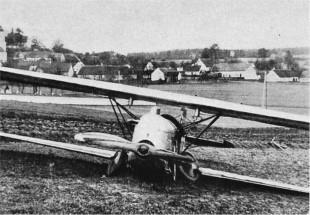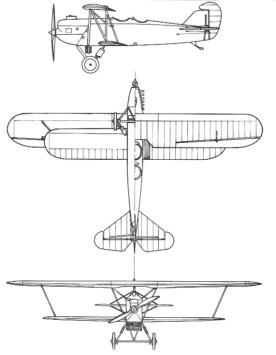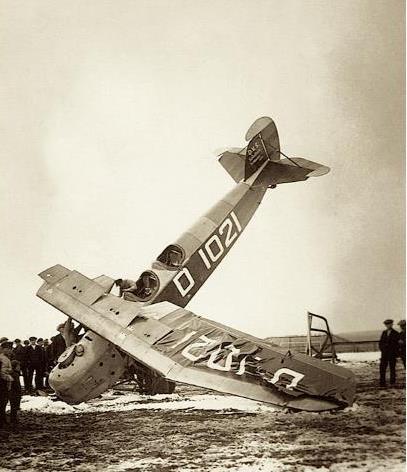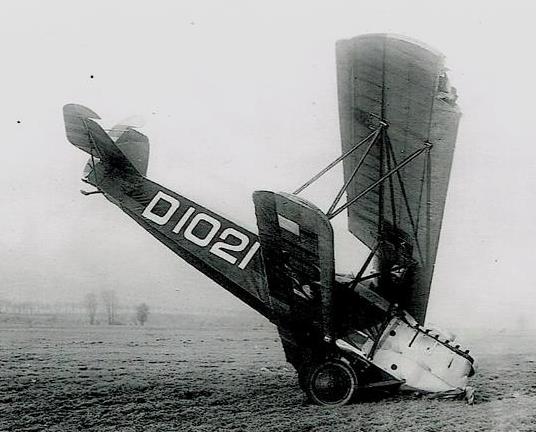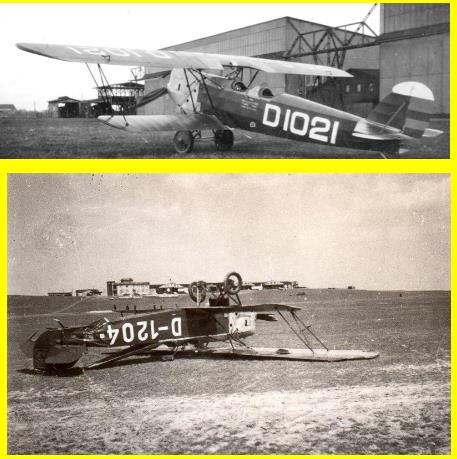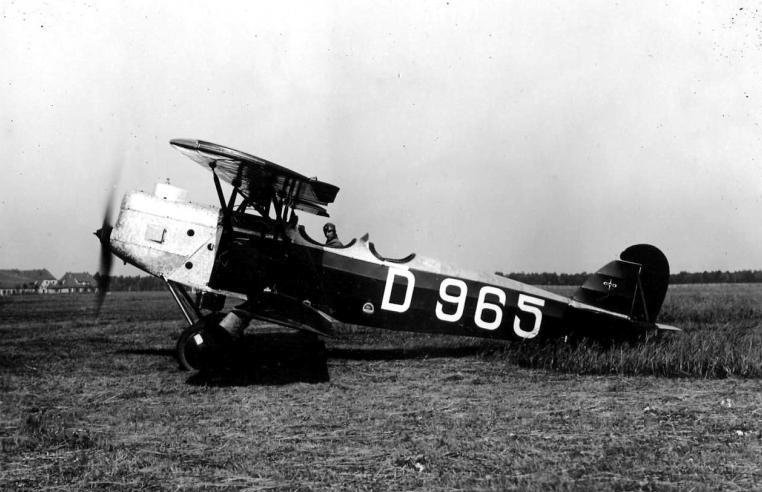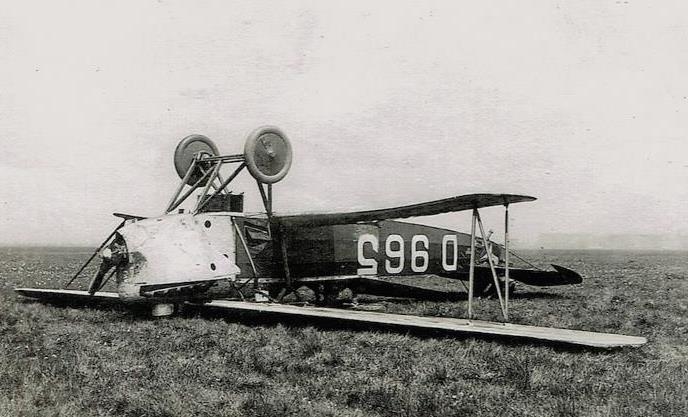NATIONAL ADVISORY COMMITTEE FOR AERONAUTICS. (From "Flugwoche," June 22, 1927, pp. 246-249.)
AIRCRAFT CIRCULAR NO. 56.
TRAINING AIRPLANE "ARADO SC l "
The "Arado SC 1M is a staggered overhung biplane- It was designed especially to meet the requirements for training. Due to its great strength and maneuverability it is, however, well adapted to stunt flying. It has excellent flight characteristics. It can easily and safely perform stunts of every description. In every position the airplane lies firmly in the air, there being no danger of an involuntary slip or spin. Even stalled flight hardly disturbs its equilibrium. The controls are all easily operated. In these excellent characteristics the "SC 1" closely resembles the "S 1," from which it was developed.
Good visibility downward is afforded by the stagger of the wings; upward, by a cutaway in the upper wing. In contrast with the "S 1," this biplane has K-struts. The stabilizer can be adjusted during flight, so as to. preserve the equilibrium for any distribution of the load. The fully loaded airplane requires a take-off run of about 80 m (262 ft.). Landing is easy, since the airplane does not lose its balance, even in horizontal gliding flight. It can be easily maneuvered on the ground without external aid.
The wings have a wood framework consisting of two spars joined by ribs. The spars have the form of box girders and are made of American spruce and birch plywood- Both upper and lower flanges are built up with glued strips to avoid defects in the wood. The ribs are strong, though easily made, and all distortion and warping is eliminated- The wings are covered with plywood from the top of the front spar to the bottom of the rear spar. This covering takes the place of inside bracing. The remaining wing surface is covered with linen, which is attached in such manner that it can be removed and replaced without injury. The fabric fastenings are attached to the ribs by a special device, so that the covering does not slacken, even after long use.
The continuous overhung upper wing is attached to the cabane at four points. The lower wing is also continuous. It is attached to the bottom of the fuselage by four bolts. The wing- suspension and end-strut fittings on both wings are made from duralumin- To prevent the sockets from enlarging they are fitted with steel linings. The oblique N-struts are made from streamlined tubing and absorb the torsion of the wings. The upper wing is provided with long narrow ailerons.
The fuselage framework is welded from steel tubing and braced with steel wires. The side walls and top of the fuselage are covered with linen. Flapping and wearing of the linen cover are prevented by sewing it to longitudinal strips. Special importance was attached to having the linen covering easily removable and replaceable. From the observer's cockpit back, the top of the fuselage is covered with removable sheets of plywood. This covering can be quickly removed, after loosening two quick-action fastenings, so as to render the inside of the fuselage and the steering controls readily accessible for inspection and repairs. The cowling of the pilot1s and pupil's cockpits is made from sheet aluminum and is easily removable through quick-action fastenings. Vibration of the sheets is almost entirely prevented- The upholstery on the edges of the openings is strong and is rendered very elastic by rubber linings. The floor of the pupil's cockpit is exchangeable- It provides the stiffening in this region. To facilitate the installation of the lower wing, the junction fittings have the form of brackets on the side walls of the fuselage.
The engine support is constructed from steel tubing and is attached with four bolts to the bow of the fuselage. The Engine rests on two longitudinal girders. The bearing surfaces are elastically supported, so as to damp the passage of the vibrations from the engine to its support. The pilot's cockpit is separated from the engine by a fire wall. An pipes and rods passing through the fire wall are made fireproof. The Engine cowling consists of aluminum sheets easily removable through quick-action fastenings. The carburetors, magnetos and spark plugs are readily accessible through ports.
The N.K.F. ribbed radiator is distinguished by its small weighty small air resistance and facility of repair. It is installed in the lower part of the fuselage near the engine. A large water tank is located above the cam shaft. It is so constructed as to prevent the spilling of the water.
Two main fuel tanks holding 140 liters (37 gallons) each and two emergency tanks of 65 liters (l? gallons) each are situated in the upper wing. All the fuel tanks are suspended by steel straps. Leaks are avoided by this arrangement- Any over-flow of the fuel during flight is prevented by a simple device. The right and left pairs of tanks each have a common fuel gauge. These gauges are so constructed, on the basis of extensive experimentation, as to preclude the possibility of failure. The gauges can be easily read by both occupants of the airplane. The oil tank is installed behind'the fire wall and is suspended like the. fuel tanks. The quantity of oil is indicated by a float.
The landing gear consists of four forward struts in the form of an M, two after struts with shock absorbers and an axle with streamlined fairing- The wear of the rubber shock absorbers is small and easily recognizable. The rubber cable can be readily exchanged.
The construction of the tail skid received special attention, both the skid proper and its shoe being readily replaceable. The rubber shock absorber can be easily exchanged. It is constructed that the load is evenly divided between the strands thus insuring minimum wear. In case the rubber cables fail, other cables protect the fuselage from injury. An emergency skid is welded to the stern of the fuselage frame.
Each member of the tail group has a steel-tubing framework covered with linen. The stabilizer is divided. The elevator is continuous and balanced, and is operated by rods. The rudder is balanced and is actuated by cables and pedals. The pilot's cockpit is behind the engine, and the observer's cockpit is behind the former. The instruments for the Control of the engine and airplane, except the compass, are all located on the instrument board in the pilot's cockpit. The compass is located in the upper wing, where it is plainly visible to both occupants and where it is less affected by the metal parts of the airplane.
The gas throttle and ignition control, as likewise the fuel cock and fire cock, can be operated, through rods, by either occupant. The fuel cocks are so constructed as to prevent all leakage and after-dripping- The starter, ignition and radiator shutter are all controlled from the pilot's cockpit. By the installation of a fire extinguisher, operated from the pilot's seat carburetor and engine fires can be smothered.
The steering control is dual. The ailerons and elevator are actuated by control sticks, and the rudder by pedals, which are adjustable as regards their distance from the seat. The after control stick can be easily removed for other uses of the airplane. The steering controls of Arado airplanes can be regarded as ideal, only a few airplanes having such convenient arrangements.
Either nose-or tail-heaviness, due to the load distribution, can be easily remedied by the pilot during flight, by means of the adjustable stabilizer. Moreover, the pupil can be shown during flight the difference between nose- and tail-heaviness. Both seats are made from sheet aluminum and are adjustable as regards height. Space is provided in the back of each seat for a parachute. The straps are shoulder straps and can be quickly and surely unbuckled by a hand-grip.
The airplane can be converted into a touring, photographic or surveying plane, by substituting a special seat for the normal seat in the observer's cockpit. Even the floor is exchangeable for this purpose. Furthermore, this airplane can also be used for the rapid transportation of.goods, since the observer´s cockpit is 1.75 m (5-74 ft.) long, 0.73 m (2.4 ft.) wide, and 0.83 m (2.72 ft.) high.
This airplane is constructed in the most careful manner in every detail. It is especially distinguished by its excellent workmanship, which is guaranteed by the carefully selected, trained and experienced personnel. Each detail is the result of years of experience. The many small defects, so common on airplanes, have been completely eliminated. This- airplane was designed by our engineer, Walther Rethel. Many of these airplanes are already in use as training and touring planes.
Translation by Dwight M. Miner,
National Advisory Committee for Aeronautics.
The Arado SC I was a biplane trainer developed in Germany in the 1920s. It was based on the S I, but powered by a far more powerful inline engine. Accordingly, the structure received considerable strengthening. The aircraft was intended for the clandestine military flying school at Lipetsk, but it was not accepted for this service. Instead, a small number were built for the Deutsche Verkehrsfliegerschule.
| Type |
2-seat trainer |
| Engine |
1 BMW IV |
| Dimensions |
Length 9.70 m, height 3.10 m, span 9.14/12.82 m, wingarea 29.32 m (upper wing 19,60 m2, lower wing 9,72 m2) |
| Weights |
Empty 1000 kg, load 500 kg, fuel kg, flying weight 1500 kg, wing loading 61,2 kg/m2, power loading 6,5 kg/hp |
| Performance |
Max. speed 183 km/h, endurance 6 h, service ceiling 5200 m, climb between 1000 and 2000 m 4,5 min., landing speed 85 km/h |
| Type |
Werk.Nr |
Registration |
History |
|
23 |
D-965 |
Delivered to Fliegerschule Staaken |
|
24 |
D-1015 |
Used by the DVL from febr./march 1928 |
|
25 |
D-1021 |
Registered Febr. 1928. Used by the DVL from febr./march 1928. Cancelled in April 1931 or destroyed ? |
|
26 |
D-1034 |
Used by the DVL from febr./march 1928 |
|
27 |
D-1035 |
Used by the DVL from febr./march 1928, later used by the DVS at Schleissheim. Destroyed in nov. 1932 |
|
28 |
D-789 |
Used by the DVL from febr./march 1928 |
|
29 |
D-1104 |
Used by the DVL from febr./march 1928 |
|
30 |
D-1191 |
Used by the DVL from febr./march 1928 |
|
32 |
D-1192 |
Used by the DVL from febr./march 1928 |
|
33 |
D-1204 |
Used by the DVL from febr./march 1928 |
|
34 |
D-1228 |
Used by the DVL from febr./march 1928 |
|
35 |
D-1241 |
Used by the DVL from febr./march 1928, later used by the DVS at Schleissheim. Destroyed in oct.. 1931 |
|
36 |
D-1251 |
Used by the DVL from febr./march 1928 |
|
37 |
D-1311 |
Used by the Erprobungsstelle Albatros at Rechlin from febr. 1928. Forcelanded in the city of Berlin (pilots Stephan von Prondzynski and Georg Wollé). Served as the prototype for the SC II. Crashed 24th of april 1928 at Warnemünde, engine failure. |


